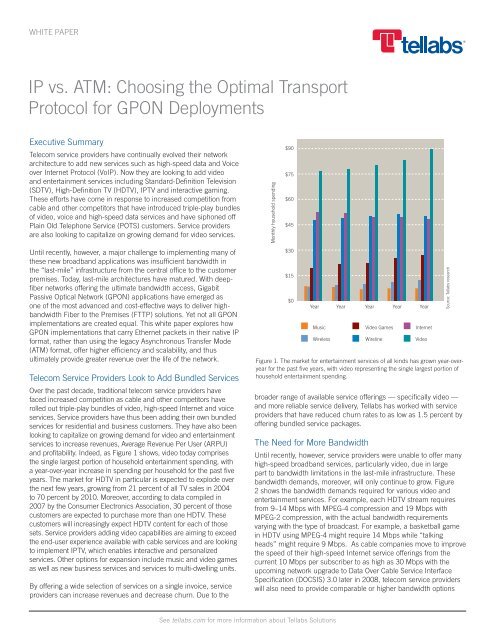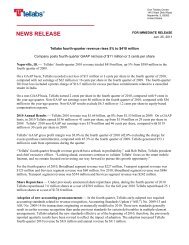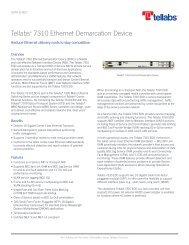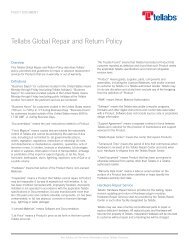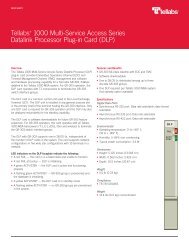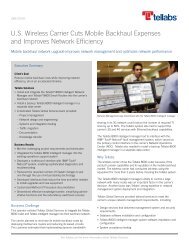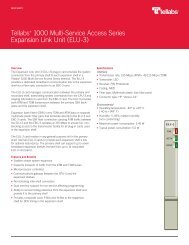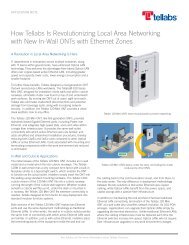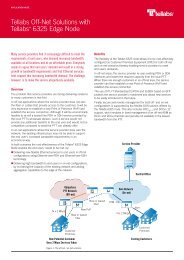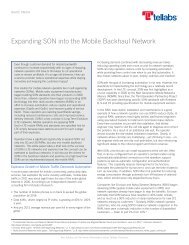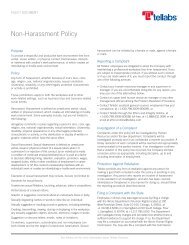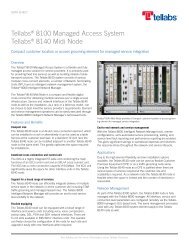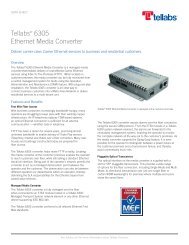IP vs. ATM: Choosing the Optimal Transport Protocol for ... - Tellabs
IP vs. ATM: Choosing the Optimal Transport Protocol for ... - Tellabs
IP vs. ATM: Choosing the Optimal Transport Protocol for ... - Tellabs
You also want an ePaper? Increase the reach of your titles
YUMPU automatically turns print PDFs into web optimized ePapers that Google loves.
WHITE PAPER<br />
<strong>IP</strong> <strong>vs</strong>. <strong>ATM</strong>: <strong>Choosing</strong> <strong>the</strong> <strong>Optimal</strong> <strong>Transport</strong><br />
<strong>Protocol</strong> <strong>for</strong> GPON Deployments<br />
Executive Summary<br />
Telecom service providers have continually evolved <strong>the</strong>ir network<br />
architecture to add new services such as high-speed data and Voice<br />
over Internet <strong>Protocol</strong> (Vo<strong>IP</strong>). Now <strong>the</strong>y are looking to add video<br />
and entertainment services including Standard-Definition Television<br />
(SDTV), High-Definition TV (HDTV), <strong>IP</strong>TV and interactive gaming.<br />
These ef<strong>for</strong>ts have come in response to increased competition from<br />
cable and o<strong>the</strong>r competitors that have introduced triple-play bundles<br />
of video, voice and high-speed data services and have siphoned off<br />
Plain Old Telephone Service (POTS) customers. Service providers<br />
are also looking to capitalize on growing demand <strong>for</strong> video services.<br />
Monthly household spending<br />
$90<br />
$75<br />
$60<br />
$45<br />
Until recently, however, a major challenge to implementing many of<br />
<strong>the</strong>se new broadband applications was insufficient bandwidth in<br />
<strong>the</strong> “last-mile” infrastructure from <strong>the</strong> central office to <strong>the</strong> customer<br />
premises. Today, last-mile architectures have matured. With deepfiber<br />
networks offering <strong>the</strong> ultimate bandwidth access, Gigabit<br />
Passive Optical Network (GPON) applications have emerged as<br />
one of <strong>the</strong> most advanced and cost-effective ways to deliver highbandwidth<br />
Fiber to <strong>the</strong> Premises (FTTP) solutions. Yet not all GPON<br />
implementations are created equal. This white paper explores how<br />
GPON implementations that carry E<strong>the</strong>rnet packets in <strong>the</strong>ir native <strong>IP</strong><br />
<strong>for</strong>mat, ra<strong>the</strong>r than using <strong>the</strong> legacy Asynchronous Transfer Mode<br />
(<strong>ATM</strong>) <strong>for</strong>mat, offer higher efficiency and scalability, and thus<br />
ultimately provide greater revenue over <strong>the</strong> life of <strong>the</strong> network.<br />
Telecom Service Providers Look to Add Bundled Services<br />
Over <strong>the</strong> past decade, traditional telecom service providers have<br />
faced increased competition as cable and o<strong>the</strong>r competitors have<br />
rolled out triple-play bundles of video, high-speed Internet and voice<br />
services. Service providers have thus been adding <strong>the</strong>ir own bundled<br />
services <strong>for</strong> residential and business customers. They have also been<br />
looking to capitalize on growing demand <strong>for</strong> video and entertainment<br />
services to increase revenues, Average Revenue Per User (ARPU)<br />
and profitability. Indeed, as Figure 1 shows, video today comprises<br />
<strong>the</strong> single largest portion of household entertainment spending, with<br />
a year-over-year increase in spending per household <strong>for</strong> <strong>the</strong> past five<br />
years. The market <strong>for</strong> HDTV in particular is expected to explode over<br />
<strong>the</strong> next few years, growing from 21 percent of all TV sales in 2004<br />
to 70 percent by 2010. Moreover, according to data compiled in<br />
2007 by <strong>the</strong> Consumer Electronics Association, 30 percent of those<br />
customers are expected to purchase more than one HDTV. These<br />
customers will increasingly expect HDTV content <strong>for</strong> each of those<br />
sets. Service providers adding video capabilities are aiming to exceed<br />
<strong>the</strong> end-user experience available with cable services and are looking<br />
to implement <strong>IP</strong>TV, which enables interactive and personalized<br />
services. O<strong>the</strong>r options <strong>for</strong> expansion include music and video games<br />
as well as new business services and services to multi-dwelling units.<br />
By offering a wide selection of services on a single invoice, service<br />
providers can increase revenues and decrease churn. Due to <strong>the</strong><br />
$30<br />
$15<br />
$0<br />
Year Year Year Year Year<br />
Music<br />
Wireless<br />
Video Games<br />
Wireline<br />
Internet<br />
Video<br />
Figure 1. The market <strong>for</strong> entertainment services of all kinds has grown year-overyear<br />
<strong>for</strong> <strong>the</strong> past five years, with video representing <strong>the</strong> single largest portion of<br />
household entertainment spending.<br />
broader range of available service offerings — specifically video —<br />
and more reliable service delivery, <strong>Tellabs</strong> has worked with service<br />
providers that have reduced churn rates to as low as 1.5 percent by<br />
offering bundled service packages.<br />
The Need <strong>for</strong> More Bandwidth<br />
Until recently, however, service providers were unable to offer many<br />
high-speed broadband services, particularly video, due in large<br />
part to bandwidth limitations in <strong>the</strong> last-mile infrastructure. These<br />
bandwidth demands, moreover, will only continue to grow. Figure<br />
2 shows <strong>the</strong> bandwidth demands required <strong>for</strong> various video and<br />
entertainment services. For example, each HDTV stream requires<br />
from 9–14 Mbps with MPEG-4 compression and 19 Mbps with<br />
MPEG-2 compression, with <strong>the</strong> actual bandwidth requirements<br />
varying with <strong>the</strong> type of broadcast. For example, a basketball game<br />
in HDTV using MPEG-4 might require 14 Mbps while “talking<br />
heads” might require 9 Mbps. As cable companies move to improve<br />
<strong>the</strong> speed of <strong>the</strong>ir high-speed Internet service offerings from <strong>the</strong><br />
current 10 Mbps per subscriber to as high as 30 Mbps with <strong>the</strong><br />
upcoming network upgrade to Data Over Cable Service Interface<br />
Specification (DOCSIS) 3.0 later in 2008, telecom service providers<br />
will also need to provide comparable or higher bandwidth options<br />
Source: <strong>Tellabs</strong> research<br />
See tellabs.com <strong>for</strong> more in<strong>for</strong>mation about <strong>Tellabs</strong> Solutions
2 <strong>IP</strong> VS. <strong>ATM</strong>: CHOOSING THE OPTIMAL TRANSPORT PROTOCOL FOR GPON DEPLOYMENTS<br />
to remain competitive. To keep up with <strong>the</strong> growth in demand <strong>for</strong><br />
increasingly higher bandwidth, service providers will need to offer at<br />
least 50 Mbps and as much as 100 Mbps to each subscriber over<br />
<strong>the</strong> next three to five years <strong>for</strong> a bundled data and <strong>IP</strong> video offering.<br />
Service Demands<br />
per Home<br />
Low BW<br />
(MPEG-4)<br />
High BW<br />
(MPEG-2)<br />
High Speed Data & Vo<strong>IP</strong> 5–30 Mbps 5–30 Mbps<br />
Gaming Stream 1–4 Mbps 1–4 Mbps<br />
VoD Stream 2 Mbps 15 Mbps<br />
PVR Stream (HDTV) 9–14 Mbps 19 Mbps<br />
Real-time SDTV Stream 2 Mbps 4 Mbps<br />
Real-time HDTV Stream 9–14 Mbps 19 Mbps<br />
Figure 2. HDTV and high-speed Internet are driving <strong>the</strong> need <strong>for</strong> more bandwidth<br />
to each home.<br />
Fiber is <strong>the</strong> ultimate carrier of bandwidth and <strong>the</strong> next major push<br />
<strong>for</strong> service providers who wish to offer broadband service bundles is<br />
fiber in <strong>the</strong> last mile. The business case <strong>for</strong> last mile fiber deployment<br />
is fur<strong>the</strong>r streng<strong>the</strong>ned by recent FCC rulings that clarify <strong>the</strong> rules<br />
of competition and level <strong>the</strong> playing field <strong>for</strong> broadband services<br />
provided by telecom service providers and cable MSOs. In particular,<br />
Incumbent Local Exchange Carriers (ILEC) are now exempt from<br />
unbundling, or making <strong>the</strong>ir networks available to competitors, if <strong>the</strong>y<br />
build FTTP networks in greenfield locations. Fur<strong>the</strong>rmore, ILECs are<br />
now only obligated to make a 64 Kbps equivalent circuit <strong>for</strong> voice<br />
access available to competitors in overbuild applications.<br />
GPON Meets Service Providers’ Requirements<br />
Today, Gigabit Passive Optical Network (GPON) — an all-fiber<br />
access architecture that links <strong>the</strong> Central Office (CO) or headend<br />
to <strong>the</strong> customer premises through a passive Optical Distribution<br />
Network (ODN) — is coming to be seen as <strong>the</strong> technology of choice<br />
<strong>for</strong> FTTP. Infonetics predicts that <strong>the</strong> market <strong>for</strong> GPON gear will grow<br />
from $740 million in 2006 to $1.4 billion in 2009. With <strong>the</strong> right<br />
implementation, GPON is capable of delivering:<br />
• High bandwidth<br />
• Enhanced scalability and low costs<br />
• Flexible deployment options<br />
• A clear migration path through support <strong>for</strong> both legacy and<br />
future services<br />
High Bandwidth<br />
With downstream speeds of 2.5 Gbps and upstream speeds of 1.2<br />
Gbps, GPON provides <strong>the</strong> necessary bandwidth to provide bundled<br />
services to customers.<br />
Relatively Low Costs<br />
While fiber offers comparable initial capital expenditure <strong>for</strong> Greenfield<br />
deployments compared to copper deployments, operational expenses<br />
are much lower. GPON technology allows <strong>the</strong> service provider to share<br />
<strong>the</strong> cost of running fiber from <strong>the</strong> CO to <strong>the</strong> premises among many<br />
users — usually up to 32 locations — resulting in lower costs than if<br />
<strong>the</strong> carrier were to deploy individual fibers to each location. The fiber<br />
is run from <strong>the</strong> CO to a centralized distribution point, from which fiber<br />
extends to each customer location. Passive optic splitters extend <strong>the</strong><br />
fiber at <strong>the</strong> distribution point, guiding <strong>the</strong> laser light on <strong>the</strong> fiber to <strong>the</strong><br />
appropriate locations. Because PONs do not require any power to <strong>the</strong><br />
outside plant to power <strong>the</strong> splitters, <strong>the</strong> resulting overall operational<br />
cost and complexity is much lower. Finally, fiber is not subject to<br />
environmental impacts, such as oxidation, that affect copper and lead<br />
to high recurring maintenance expenses. Overall, while copper costs<br />
in <strong>the</strong> neighborhood of $100 per line annually, operational costs <strong>for</strong><br />
fiber are significantly lower, as shown in Figure 3.<br />
Architecture Comparison on OpEx: PON, HFC, xDSL<br />
$10,000,000<br />
$9,000,000<br />
$8,000,000<br />
$7,000,000<br />
$6,000,000<br />
$5,000,000<br />
$4,000,000<br />
$3,000,000<br />
$2,000,000<br />
$1,000,000<br />
$0<br />
xDSL<br />
HFC<br />
PON<br />
Significant OpEx savings over time<br />
1 2 3 4 5 6 7 8 9 10 11 12 13 14 15<br />
Year<br />
2004 Fiber-to-<strong>the</strong>-Home Conference & Expo — FTTH 101 Track — Economics of FTTH<br />
Figure 3. Operational costs <strong>for</strong> fiber are significantly lower than those <strong>for</strong> copper<br />
See tellabs.com <strong>for</strong> more in<strong>for</strong>mation about <strong>Tellabs</strong> Solutions
3 <strong>IP</strong> VS. <strong>ATM</strong>: CHOOSING THE OPTIMAL TRANSPORT PROTOCOL FOR GPON DEPLOYMENTS<br />
Flexible Deployment Options<br />
In some cases, it may not make sense to run fiber directly to <strong>the</strong><br />
premises, but ra<strong>the</strong>r to use <strong>the</strong> existing copper infrastructure <strong>for</strong><br />
<strong>the</strong> last mile with VDSL2 or ADSL2+ and <strong>the</strong>n migrate over time<br />
to an all fiber network. The right Multiservice Access Plat<strong>for</strong>m<br />
(MSAP) can provide a clear and seamless path to FTTP while<br />
leveraging <strong>the</strong> existing copper infrastructure using VDSL2 and/or<br />
ADSL2+ technologies.<br />
A Clear Migration Path<br />
The correct GPON implementation can also offer a clear migration<br />
path <strong>for</strong> adding services without disrupting existing equipment or<br />
altering <strong>the</strong> transport layer in any way because it supports emerging<br />
and legacy services, including video, high-speed data, business<br />
services and services to multi-dwelling units.<br />
Video: Standard Video, VoD and <strong>IP</strong>TV<br />
GPON supports both Radio Frequency (RF) video overlay and<br />
<strong>IP</strong>TV, allowing service providers to maximize existing investments in<br />
headend equipment without impeding <strong>the</strong>ir migration to <strong>IP</strong>TV.<br />
With RF video overlay, <strong>the</strong> broadcast video is carried as a separate<br />
wavelength outside <strong>the</strong> normal downstream data path to enable <strong>the</strong><br />
complete group of broadcast video channels to be transported over<br />
composite RF signals at up to 870 MHz. Service providers can<br />
transport signals, including video, from a video headend over a<br />
GPON infrastructure by using Erbuim-Doped Fiber Amplifiers<br />
(EDFA) with a Wavelength Division Multiplexer (WDM) to combine<br />
<strong>the</strong> video and o<strong>the</strong>r optical transport signals onto a single fiber.<br />
Service providers can deliver two-way interactive digital services (e.g.,<br />
Video on Demand (VoD)) over GPON using a two-way digital cable<br />
headend. The set-top box on <strong>the</strong> downstream end receives analog<br />
or digital video streams and can communicate upstream with <strong>the</strong><br />
headend <strong>for</strong> interactive services. Optical Network Terminals (ONT)<br />
are available that allow service providers to add a fourth wavelength<br />
upstream using <strong>the</strong> latest standards <strong>for</strong> RF over Glass (RFoG).<br />
Service providers can deliver <strong>IP</strong> video via GPON by using an <strong>IP</strong><br />
video headend that injects <strong>IP</strong> into <strong>the</strong> network downstream to<br />
subscriber-premises ONTs. The <strong>IP</strong> video is carried in band with<br />
broadband services over <strong>the</strong> GPON infrastructure to homes that<br />
have an <strong>IP</strong> interface. Signal transport is initiated automatically when<br />
a viewer selects a channel, triggering a request <strong>for</strong> service back to<br />
<strong>the</strong> system CO.<br />
High-Speed Data Services<br />
High-speed data access via 100Base-T and 1000Base-T E<strong>the</strong>rnet<br />
connections at <strong>the</strong> ONT are critical <strong>for</strong> both residential and business<br />
users alike. Service providers can take advantage of this demand<br />
and market a much wider range of data services (including higher<br />
bandwidth data services) with GPON. This includes <strong>the</strong> ability to offer<br />
high-speed symmetrical services, something competitive high-speed<br />
infrastructures often struggle to provide.<br />
Business Services<br />
GPON implementations are available that are capable of supporting<br />
both existing and legacy business services. These include Digital<br />
Loop Carrier (DLC) services/circuits such as DDS, ISDN, coin/<br />
payphone, 2-wire and 4-wire special services, 2-wire and 4-wire<br />
transmit only services, and many o<strong>the</strong>rs. Implementations are<br />
available that allow service providers to:<br />
• Provide <strong>the</strong>se services over a DLC architecture while supporting<br />
GPON in <strong>the</strong> same chassis<br />
• Provide <strong>the</strong>se services over GPON<br />
• Support both sets of services with a plan <strong>for</strong> GPON migration<br />
when <strong>the</strong> portion of <strong>the</strong> network supporting DLC services warrants<br />
a full GPON upgrade<br />
Multi-Dwelling Units<br />
To deliver high-speed broadband services to Multi-Dwelling Units<br />
(MDU) such as apartments and high-rise buildings, service<br />
providers can run GPON into <strong>the</strong> telephone room and <strong>the</strong>n run<br />
individual links via wiring in risers within <strong>the</strong> building (often copper<br />
and/or CAT-5 E<strong>the</strong>rnet). Typical services interfaces <strong>for</strong> MDU and<br />
MTU applications include ADSL2+, VDSL2 and native E<strong>the</strong>rnet<br />
carried over <strong>the</strong> existing wiring.<br />
<strong>Choosing</strong> <strong>the</strong> <strong>Optimal</strong> GPON Implementation<br />
GPON provides a smooth upgrade path from legacy to nextgeneration<br />
services, in part through its support <strong>for</strong> legacy traffic<br />
in its native <strong>for</strong>mat (e.g., <strong>ATM</strong> and TDM) and native <strong>IP</strong> traffic.<br />
However, because GPON equipment vendors have <strong>the</strong> option of<br />
transporting traffic in <strong>ATM</strong> or in native <strong>IP</strong>, service providers need to<br />
consider <strong>the</strong> transport protocol that <strong>the</strong> GPON equipment vendor<br />
chooses since this has significant implications <strong>for</strong> efficiency,<br />
per<strong>for</strong>mance and scalability.<br />
GPON Encapsulation Mode (GEM) is <strong>the</strong> method that maps <strong>the</strong><br />
service layers (TDM, <strong>ATM</strong>, <strong>IP</strong>) onto <strong>the</strong> PON physical layer. This<br />
flexibility to carry several protocol <strong>for</strong>mats allows both legacy <strong>ATM</strong><br />
access plat<strong>for</strong>ms and next-generation <strong>IP</strong>/E<strong>the</strong>rnet access plat<strong>for</strong>ms<br />
to support <strong>the</strong> latest GPON technology. But, <strong>the</strong> choice of underlying<br />
technology (<strong>IP</strong> <strong>vs</strong>. <strong>ATM</strong>) has a significant impact on efficiency,<br />
scalability and ultimately, service delivery. If <strong>the</strong> access plat<strong>for</strong>m<br />
utilizes <strong>ATM</strong> as <strong>the</strong> core transport and switching technology, <strong>the</strong><br />
ability to deliver bandwidth and generate revenue will be greatly<br />
diminished. The following discussion explains why service providers<br />
are best served through GPON implementations that use native <strong>IP</strong>,<br />
ra<strong>the</strong>r than <strong>ATM</strong>.<br />
An In-Depth Look at Why <strong>IP</strong> is More Efficient than <strong>ATM</strong><br />
<strong>ATM</strong> was <strong>the</strong> first transport protocol able to reliably carry multi-QoS<br />
broadband services over older service technologies, including T1,<br />
G.SHDSL and ADSL. Designed specifically to offer granular QoS over<br />
relatively low-speed, low-bandwidth links, <strong>ATM</strong> was challenged by<br />
<strong>the</strong> adoption of high-speed E<strong>the</strong>rnet technology beginning in <strong>the</strong><br />
mid 1990s.<br />
See tellabs.com <strong>for</strong> more in<strong>for</strong>mation about <strong>Tellabs</strong> Solutions
4 <strong>IP</strong> VS. <strong>ATM</strong>: CHOOSING THE OPTIMAL TRANSPORT PROTOCOL FOR GPON DEPLOYMENTS<br />
<strong>Transport</strong> Efficiency — E<strong>the</strong>rnet <strong>vs</strong> <strong>ATM</strong><br />
Efficiency (%)<br />
100.0%<br />
90.0%<br />
80.0%<br />
70.0%<br />
60.0%<br />
50.0%<br />
40.0%<br />
30.0%<br />
20.0%<br />
E<strong>the</strong>rnet Efficiency<br />
<strong>ATM</strong> Efficiency<br />
86%<br />
42%<br />
Average<br />
data<br />
packet<br />
size<br />
Average<br />
Vo<strong>IP</strong><br />
packet<br />
size<br />
10.0%<br />
0.0%<br />
64<br />
126<br />
188<br />
250<br />
312<br />
374<br />
436<br />
498<br />
560<br />
622<br />
684<br />
746<br />
808<br />
870<br />
932<br />
994<br />
1056<br />
1118<br />
1180<br />
1242<br />
1304<br />
1366<br />
1428<br />
1490<br />
E<strong>the</strong>rnet Packet Length (bytes)<br />
Figure 4. GPON using native <strong>IP</strong> offers efficiency greater than 98 percent while efficiency drops to 40–80 percent using <strong>ATM</strong>.<br />
Today, <strong>the</strong> industry has moved from <strong>ATM</strong> to high-speed, high-density<br />
technology that uses native <strong>IP</strong>/E<strong>the</strong>rnet packets in <strong>the</strong> physical layer.<br />
A typical Vo<strong>IP</strong> flow requires approximately 100 kbps of bandwidth<br />
at <strong>the</strong> E<strong>the</strong>rnet layer. When <strong>ATM</strong> is used to carry this service, <strong>the</strong><br />
required bandwidth at <strong>the</strong> <strong>ATM</strong> layer is approximately 220 kbps.<br />
The result is 2.2 times <strong>the</strong> bandwidth required by choosing <strong>ATM</strong><br />
technology on your GPON plat<strong>for</strong>m.<br />
Native <strong>IP</strong>/E<strong>the</strong>rnet is <strong>the</strong> transport of choice <strong>for</strong> newer service<br />
technologies including ADSL2+ and VDSL2. Coupled with carrierclass<br />
QoS, <strong>IP</strong> becomes superior to <strong>ATM</strong> <strong>for</strong> modern high-bandwidth,<br />
high-density applications, leveraging <strong>the</strong> scalability and flexibility<br />
of <strong>IP</strong> and <strong>the</strong> reliability instilled with QoS mechanisms. In contrast,<br />
<strong>ATM</strong> efficiency varies with <strong>the</strong> length of <strong>the</strong> E<strong>the</strong>rnet packet. For<br />
services that utilize smaller packets, such as Vo<strong>IP</strong>, efficiency is in<br />
<strong>the</strong> mid to upper 40 percent range. As E<strong>the</strong>rnet datagrams get<br />
larger <strong>for</strong> video, <strong>ATM</strong> becomes more efficient — in <strong>the</strong> range of<br />
70–80 percent. However, this efficiency rate remains far lower than<br />
native E<strong>the</strong>rnet mapping over <strong>the</strong> same transport medium. Figure 4<br />
illustrates <strong>the</strong> differences in efficiency between <strong>ATM</strong> and <strong>IP</strong>.<br />
As a result, compared with <strong>ATM</strong>, <strong>IP</strong> over GPON offers:<br />
• Better bandwidth utilization<br />
• High transport efficiency, which means service providers can<br />
deliver more bandwidth to subscribers on a given infrastructure<br />
• Greater scalability<br />
<strong>ATM</strong> Encapsulation Wastes Bandwidth<br />
<strong>ATM</strong>’s low efficiency relative to <strong>IP</strong> is <strong>the</strong> result of <strong>the</strong> many layers of<br />
encapsulation required to convert <strong>ATM</strong> to E<strong>the</strong>rnet, which wastes<br />
considerable bandwidth within <strong>the</strong> plat<strong>for</strong>m. As Figure 5 illustrates,<br />
converting <strong>ATM</strong> to E<strong>the</strong>rnet requires <strong>the</strong> following encapsulation layers:<br />
• RFC-2684 (Multiprotocol Encapsulation over <strong>ATM</strong> Adaptation<br />
Layer 5) — The first step in <strong>the</strong> encapsulation process, outlined<br />
in RFC-2684, adds a header to <strong>the</strong> front (LLC/SNAP) and a Frame<br />
Check Sequence (FCS) to <strong>the</strong> back of <strong>the</strong> E<strong>the</strong>rnet frame. Thus,<br />
to an initial E<strong>the</strong>rnet frame of 68 bytes, <strong>the</strong> header and <strong>the</strong> frame<br />
check add 20 bytes of overhead. The efficiency is immediately<br />
reduced to 77 percent.<br />
• Common Part Convergence Sub-layer (CPCS)-PDU layer — This<br />
second layer of encapsulation adds CPCS padding to <strong>the</strong> front of<br />
<strong>the</strong> frame so that it fits exactly into <strong>the</strong> <strong>ATM</strong> cell and a redundancy<br />
check to <strong>the</strong> back. Thus, to <strong>the</strong> 88 byte frame length created in<br />
<strong>the</strong> previous step, this step adds 56 more bytes of encapsulation<br />
<strong>for</strong> ano<strong>the</strong>r drop in efficiency to 61.1%.<br />
• <strong>ATM</strong> Segmentation and Reassembly layer — In this third layer of<br />
encapsulation, <strong>the</strong> E<strong>the</strong>rnet packet is segmented into multiple<br />
<strong>ATM</strong> cells. It takes many <strong>ATM</strong> cells to carry a single E<strong>the</strong>rnet<br />
packet. Each <strong>ATM</strong> cell is a total of 53 bytes in length with 48<br />
bytes in <strong>the</strong> payload and 5 bytes in <strong>the</strong> header — which means<br />
that 5 bytes of bandwidth are wasted <strong>for</strong> each 48-byte segment<br />
<strong>for</strong> efficiency rate in this layer of 90.6 percent. At this point, <strong>the</strong><br />
overall E<strong>the</strong>rnet — <strong>ATM</strong> cell efficiency <strong>for</strong> this 68-byte E<strong>the</strong>rnet<br />
packet is 42.8%.<br />
• Added to this encapsulation, <strong>the</strong> mechanism that provides <strong>the</strong><br />
steering logic necessary to deliver <strong>the</strong> <strong>ATM</strong> cells from one line<br />
card to ano<strong>the</strong>r requires a fourth layer of overhead, which some<br />
vendors call a “packet.” A serial transport on <strong>the</strong> backplane<br />
typically runs at 2.48 Mbps carrying <strong>the</strong> packets between line<br />
cards. This steering logic adds 11 bytes to <strong>the</strong> 53 byte <strong>ATM</strong> cell to<br />
create a “protocol agnostic” 64 byte packet, fur<strong>the</strong>r reducing <strong>the</strong><br />
42.8% efficiency in <strong>the</strong> above example to 35.4% overall transport<br />
efficiency through <strong>the</strong> <strong>ATM</strong> plat<strong>for</strong>m.<br />
See tellabs.com <strong>for</strong> more in<strong>for</strong>mation about <strong>Tellabs</strong> Solutions
5 <strong>IP</strong> VS. <strong>ATM</strong>: CHOOSING THE OPTIMAL TRANSPORT PROTOCOL FOR GPON DEPLOYMENTS<br />
64–1518 bytes<br />
E<strong>the</strong>rnet Packet<br />
E<strong>the</strong>rnet frame<br />
RFC-2684<br />
Inter-working<br />
LLCSNAP<br />
E<strong>the</strong>rnet Packet<br />
FCS<br />
Overhead<br />
CPCS<br />
Layer<br />
CPCS • Padding<br />
LLCSNAP<br />
E<strong>the</strong>rnet Packet<br />
FCS<br />
CRC<br />
<strong>ATM</strong> SAR<br />
LayerRFC-2684<br />
H<br />
Payload<br />
H<br />
Payload<br />
H<br />
Payload<br />
H Payload H Payload H Payload<br />
<strong>ATM</strong> Cell<br />
Figure 5. <strong>ATM</strong> encapsulation buries <strong>the</strong> <strong>IP</strong>/E<strong>the</strong>rnet protocol in three layers of overhead.<br />
This system overhead, combined with additional inefficiencies<br />
due to <strong>the</strong> fact that <strong>ATM</strong> has not been updated in nearly 10 years,<br />
means that each subscriber can end up with as little as 14 Mbps,<br />
which is just 17 percent of <strong>the</strong> available bandwidth on a native <strong>IP</strong>/<br />
E<strong>the</strong>rnet GPON port. Thus, an amount of bandwidth that was once<br />
adequate ends up carrying a much smaller E<strong>the</strong>rnet payload — and<br />
<strong>the</strong> E<strong>the</strong>rnet payload is <strong>the</strong> portion of bandwidth carrying revenuegenerating<br />
traffic.<br />
<strong>IP</strong> Offers Efficient Bandwidth Utilization and Full Linear<br />
Scalability<br />
In contrast, a solution that uses native <strong>IP</strong> with a nonblocking<br />
architecture provides enough bandwidth to enable <strong>the</strong> packets<br />
delivered to <strong>the</strong> plat<strong>for</strong>m to egress to <strong>the</strong> subscriber with no<br />
bottlenecks. Thus, with an all <strong>IP</strong>/E<strong>the</strong>rnet plat<strong>for</strong>m, a four port<br />
GPON module can effectively deliver 10 Gbps of E<strong>the</strong>rnet services<br />
<strong>for</strong> subscriber revenue generation. As a result, <strong>IP</strong> over GPON offers<br />
full linear scalability.<br />
In short, increasing system density over time will result in a<br />
decreased service offering per subscriber. Ultimately, system level<br />
Average Revenue Per User (ARPU) decreases with time and churn<br />
increases. In contrast, an <strong>IP</strong> plat<strong>for</strong>m with nonblocking architecture<br />
delivers <strong>the</strong> required bandwidth until it reaches capacity. The only<br />
limit to capacity is <strong>the</strong> number of network interfaces <strong>the</strong> service<br />
provider installs.<br />
<strong>Tellabs</strong> Delivers on These Requirements<br />
<strong>Tellabs</strong> is a leader in providing deep fiber solutions in North America<br />
with nearly two million PON ONTs shipped to date, and has provided<br />
commercially available VDSL2 solutions since 2005. As Figure 7<br />
illustrates, <strong>the</strong>se solutions offer a flexible migration path from digital<br />
copper to GPON fiber through support <strong>for</strong>:<br />
• FTTP<br />
• Fiber to <strong>the</strong> Node (FTTN) with ADSL2+ and VDSL2<br />
• Fiber to <strong>the</strong> Curb (FTTC) with ADSL2+ and VDSL2<br />
High Efficiency Means Greater Revenue<br />
Service providers find <strong>the</strong>mselves with a continual need to profitably<br />
increase bandwidth. Residential and business customers constantly<br />
expect more bandwidth, and as <strong>the</strong> cost per megabit <strong>for</strong> services<br />
declines, service providers must increase service/bandwidth<br />
offerings to achieve <strong>the</strong> same or better ARPU. For example, monthly<br />
cost per megabit of residential service is decreasing from $25 in<br />
2002 to an expected $1 in 2010. Since <strong>the</strong> sweet spot <strong>for</strong> residential<br />
customers is $50 per month, service providers will need to offer 50<br />
Mbps at $1 per megabit by 2010. Thus, GPON’s ability to deliver<br />
scalable bandwidth will have a large impact on <strong>the</strong> revenue that can<br />
be generated <strong>for</strong> each card — and on long-term revenue overall.<br />
Bandwidth<br />
per user<br />
(Mbps)<br />
75M<br />
14M<br />
<strong>IP</strong>/E<strong>the</strong>rnet OLT<br />
Typical<br />
<strong>ATM</strong> OLT<br />
System<br />
revenue<br />
dollars<br />
When GPON is deployed on a <strong>ATM</strong>-based plat<strong>for</strong>m, once <strong>the</strong> system<br />
hits a certain percent of chassis capacity, it reaches its maximum<br />
serving capacity and <strong>the</strong> bandwidth delivered per user begins to<br />
decline as new subscribers are turned up, as shown in Figure 6.<br />
0<br />
17% 100%<br />
System capacity (%)<br />
Figure 6. With <strong>ATM</strong> on GPON, increasing system density reduces <strong>the</strong> services<br />
telecom companies can offer each subscriber; <strong>IP</strong> offers no such limitations.<br />
See tellabs.com <strong>for</strong> more in<strong>for</strong>mation about <strong>Tellabs</strong> Solutions
6 <strong>IP</strong> VS. <strong>ATM</strong>: CHOOSING THE OPTIMAL TRANSPORT PROTOCOL FOR GPON DEPLOYMENTS<br />
FTTPremise<br />
GPON<br />
Internet<br />
Video Hub<br />
Office<br />
<strong>Tellabs</strong> ONU<br />
2.4Gbps<br />
GPON<br />
1600<br />
<strong>Tellabs</strong><br />
ONT<br />
1600<br />
7100<br />
7100<br />
Optical Packet<br />
Metro<br />
CO DSLAM<br />
FTTCell Site<br />
1600<br />
7100<br />
1150/1134<br />
<strong>Tellabs</strong> ONU<br />
Vo<strong>IP</strong>/PSTN<br />
7100<br />
Voice Switch<br />
DS1<br />
GbE<br />
8830<br />
1000<br />
LET/Voice<br />
Gateway<br />
1150/1134<br />
Pt-to-Pt<br />
1Gbps E<strong>the</strong>rnet<br />
VDSL2/ADSL2+<br />
FTTCurb<br />
1150<br />
VDSL2/ADSL2+<br />
E<strong>the</strong>rnet Rings<br />
(ITU G.8032 compliant)<br />
FTTNode<br />
Remote Terminal<br />
Augmentation — Fiber<br />
extensions, enabling <strong>IP</strong><br />
1134<br />
1000<br />
1134<br />
GPON<br />
1600<br />
BBDLC<br />
Clear and Fill — Upgrading<br />
older cabinets with<br />
new, <strong>IP</strong>-enabled systems<br />
1600<br />
Passive Fiber<br />
Active Fiber<br />
Figure 7. <strong>Tellabs</strong> access solutions offer <strong>the</strong> flexibility to deploy a full range of services.<br />
The <strong>Tellabs</strong> deep fiber solutions also offer a full complement of<br />
high-speed data and existing as well as existing and legacy business<br />
services including:<br />
• Symmetrical data<br />
• Radio Frequency over Glass (RFoG)<br />
• Digital Loop Carrier (DLC) services such as:<br />
– Digital Data Services (DDS)<br />
– Integrated Services Digital Network<br />
– Coin/payphone<br />
– 2-wire and 4-wire special services<br />
– 2-wire and 4-wire transmit only services<br />
<strong>Tellabs</strong> fiber access solutions allow service providers to support<br />
both broadband DLC architectures and <strong>the</strong> latest in all-fiber GPON<br />
technology concurrently. The integrated architecture supports<br />
cost-effective migration from a copper-to-optical outside plant<br />
infrastructure in a contolled manner.<br />
Industry-leading <strong>Tellabs</strong> technology helps enable service providers<br />
to succeed through a suite of product and professional services<br />
solutions that includes MSAPs, GPON ONTs and voice gateways.<br />
The <strong>Tellabs</strong> ® 1150 Multiservice Access Plat<strong>for</strong>m (MSAP) is a<br />
feature-rich, native end-to-end <strong>IP</strong>/E<strong>the</strong>rnet delivery plat<strong>for</strong>m that<br />
offers <strong>the</strong> packet-based high-bandwidth technology required<br />
<strong>for</strong> today’s in-demand telecommunications services. Flexible<br />
applications — FTTN, FTTC and FTTP as well as support <strong>for</strong><br />
traditional DLC-based services — help providers chart migration<br />
paths maximized <strong>for</strong> competitive customer rollouts and manageable<br />
CapEx/OpEx impact.<br />
See tellabs.com <strong>for</strong> more in<strong>for</strong>mation about <strong>Tellabs</strong> Solutions
7 <strong>IP</strong> VS. <strong>ATM</strong>: CHOOSING THE OPTIMAL TRANSPORT PROTOCOL FOR GPON DEPLOYMENTS<br />
The <strong>Tellabs</strong> ® 1150 MSAP is a high-density access plat<strong>for</strong>m designed<br />
to help service providers stay ahead of <strong>the</strong> technology curve and<br />
support competitive offerings to consumer and business customers.<br />
Focused on deep fiber solutions service delivery, <strong>the</strong> <strong>Tellabs</strong> 1150<br />
MSAP features an <strong>IP</strong>/E<strong>the</strong>rnet architecture that supports optimized,<br />
scalable service delivery:<br />
• Native <strong>IP</strong>/E<strong>the</strong>rnet architecture<br />
• <strong>IP</strong> transport, including E<strong>the</strong>rnet rings<br />
• Residential and business high-speed services<br />
• Symmetrical and asymmetrical services<br />
• Transparent LAN Service (TLS)<br />
• RF return compliant with RFoG standards<br />
• Transparent LAN Service (TLS)<br />
• Integrated DLC special circuits<br />
• Unified Element Management System (EMS)<br />
Designed to support high-capacity FTTP, FTTN and FTTC<br />
deployments via a powerful nonblocking architecture, <strong>the</strong> <strong>Tellabs</strong><br />
1150 MSAP is a <strong>for</strong>ward-looking access solution that can be<br />
deployed at cost parity to traditional copper networks. The <strong>Tellabs</strong><br />
1150 MSAP leverages <strong>the</strong> practically limitless capacity of fiber optic<br />
cable to help support extremely high-speed broadband networks<br />
over very short copper connections.<br />
The <strong>Tellabs</strong> ® 1134 Multiservice Access Plat<strong>for</strong>m (MSAP) offers a<br />
medium-density, full-service option — <strong>for</strong> smaller MSAP deep-fiber<br />
applications — that supports full-service GigE FTTC, GPON FTTP<br />
or FTTN applications supporting broadband, narrowband and legacy<br />
copper services. The <strong>Tellabs</strong> 1134 MSAP is designed to be deployed<br />
in existing cabinets to enable a flexible, remote MSAP that supports<br />
multi-shelf GigE aggregation/transport to <strong>the</strong> CO and migration to<br />
FTTN, GPON FTTP, GigE FTTC and future E<strong>the</strong>rnet rings.<br />
The <strong>Tellabs</strong> ® 1600 Series of GPON ONTs enables <strong>the</strong> delivery of<br />
integrated, high-speed services to both residential and business<br />
customers at a reasonable cost. Single-family Unit (SFU) ONTs<br />
provide interfaces <strong>for</strong> POTS, Gigabit E<strong>the</strong>rnet and both Multimedia<br />
over Coax Alliance (MOCA) and RF video. S<strong>IP</strong>-ready, <strong>the</strong> SFU ONTs<br />
are easily migrated to a softswitch environment. Business ONTs are<br />
available in several integrated, rack-mount units, as well as a modular<br />
chassis-based model. Each business ONT supports multiple<br />
densities of POTS, GigE, VDSL2 and T1 services. The modular,<br />
chassis-based unit also supports an extensive list of special circuits.<br />
The <strong>Tellabs</strong> ® 1000 Multiservice Access Plat<strong>for</strong>m (MSAP) Voice<br />
Gateway (VGW) per<strong>for</strong>ms S<strong>IP</strong> to TDM conversions in all-<strong>IP</strong><br />
networks, providing a cost-effective transition to Vo<strong>IP</strong>. Offering<br />
standard Vo<strong>IP</strong> <strong>for</strong> voice, <strong>the</strong> VGW broadens competitive service<br />
offerings, enabling service providers to offer bundled <strong>IP</strong> services.<br />
The <strong>Tellabs</strong> 1000 MSAP can also aggregate multiple exchanges via<br />
<strong>the</strong> <strong>IP</strong> network via aggregation to a single <strong>Tellabs</strong> 1000 MSAP VGW<br />
to replace multiple legacy voice switches. This gateway utilizes S<strong>IP</strong><br />
<strong>for</strong> Bearer setup and teardown, with signaling passed transparently<br />
via FRC 2933 messages. In addition to support <strong>for</strong> Class 5<br />
interfaces (GR-303, TR-08, Mode I and Mode II), <strong>the</strong> <strong>Tellabs</strong> 1000<br />
VGW also supports INA interfaces <strong>for</strong> special service circuits.<br />
The <strong>Tellabs</strong> ® Panorama Integrated Network Manager (INM)<br />
offers unified management support <strong>for</strong> <strong>the</strong> entire suite of <strong>Tellabs</strong><br />
access products. The <strong>Tellabs</strong> Panorama INM enables service<br />
providers to monitor and provision various elements in <strong>the</strong>ir<br />
network from a centralized system, increasing efficiency and saving<br />
OpEx while providing quicker service turn up and time to revenue.<br />
Summary/Conclusion<br />
As customers continue to demand new bandwidth-rich services,<br />
service providers are increasingly looking to fiber-oriented solutions<br />
like GPON/FTTP, FTTC or FTTN with ADSL2+ or VDSL2 to provide<br />
<strong>the</strong> necessary bandwidth at <strong>the</strong> last mile. Using a solution that<br />
currently offers or incorporates a migration plan to <strong>IP</strong>/E<strong>the</strong>rnet<br />
service delivery allows service providers to maximize <strong>the</strong>ir usage of<br />
this bandwidth to provide more services to larger numbers of<br />
subscribers — and <strong>the</strong>reby increase <strong>the</strong> revenue <strong>the</strong>y can derive<br />
from <strong>the</strong> system. <strong>Tellabs</strong> offers <strong>the</strong> full range of services and<br />
solutions, including MSAPs, ONTs, voice gateways and network<br />
management systems, that allow service providers to implement a<br />
feature-rich, native end-to-end <strong>IP</strong>/E<strong>the</strong>rnet delivery plat<strong>for</strong>m that<br />
offers <strong>the</strong> packet-based high-bandwidth technology and flexibility<br />
required <strong>for</strong> today’s in-demand telecommunications services.<br />
<strong>Tellabs</strong> solutions also provide <strong>the</strong> bandwidth and flexibility to<br />
support service providers well into <strong>the</strong> future.<br />
North America<br />
<strong>Tellabs</strong><br />
One <strong>Tellabs</strong> Center<br />
1415 West Diehl Road<br />
Naperville, IL 60563<br />
U.S.A.<br />
+1 630 798 8800<br />
Fax: +1 630 798 2000<br />
Asia Pacific<br />
<strong>Tellabs</strong><br />
3 Anson Road<br />
#14–01 Springleaf Tower<br />
Singapore 079909<br />
Republic of Singapore<br />
+65 6215 6411<br />
Fax: +65 6215 6422<br />
Europe, Middle East & Africa<br />
<strong>Tellabs</strong><br />
Abbey Place<br />
24–28 Easton Street<br />
High Wycombe, Bucks<br />
HP11 1NT<br />
United Kingdom<br />
+44 871 574 7000<br />
Fax: +44 871 574 7151<br />
Latin America & Caribbean<br />
<strong>Tellabs</strong><br />
Rua James Joule No. 92<br />
EDIFÍCIO PLAZA I<br />
São Paulo – SP<br />
04576-080<br />
Brasil<br />
+55 11 3572 6200<br />
Fax: +55 11 3572 6225<br />
The following trademarks and service marks are owned by <strong>Tellabs</strong> Operations, Inc., or its affiliates in <strong>the</strong> United States and/or in o<strong>the</strong>r countries: TELLABS ® , TELLABS and T symbol ® , and T symbol ® . Statements herein may contain projections or o<strong>the</strong>r<br />
<strong>for</strong>ward-looking statements regarding future events, products, features, technology and resulting commercial or technological benefits and advantages. These statements are <strong>for</strong> discussion purposes only, are subject to change and are not to be construed<br />
as instructions, product specifications, guarantees or warranties. Actual results may differ materially. The in<strong>for</strong>mation contained herein is not a commitment, promise or legal obligation to deliver any material, code, feature or functionality. It is intended to<br />
outline <strong>Tellabs</strong>’ general product direction. The development, release and timing of any material, code, feature or functionality described herein remains at <strong>Tellabs</strong>’ sole discretion.<br />
© 2011 <strong>Tellabs</strong>. All rights reserved. 74.1983E Rev. B 2/11


